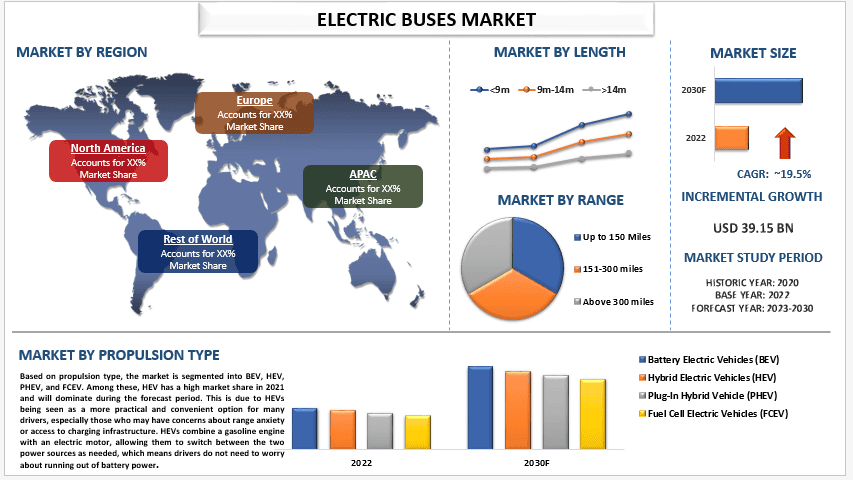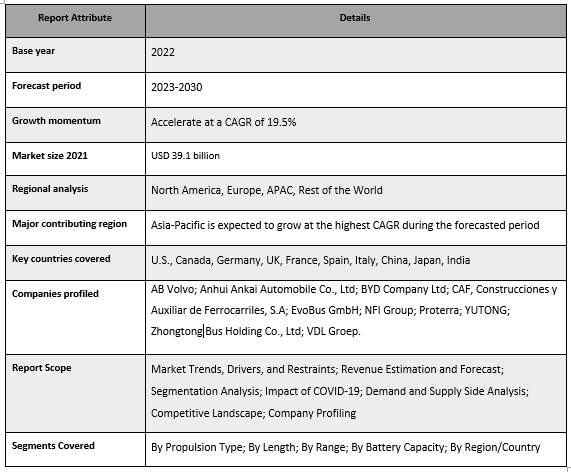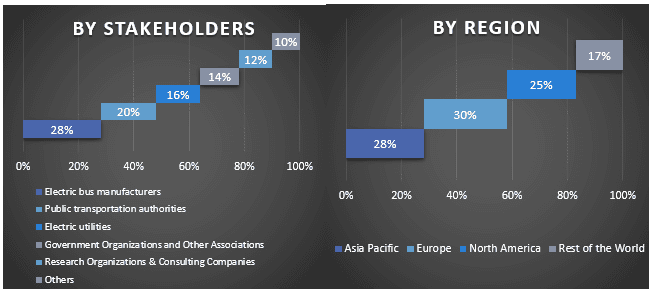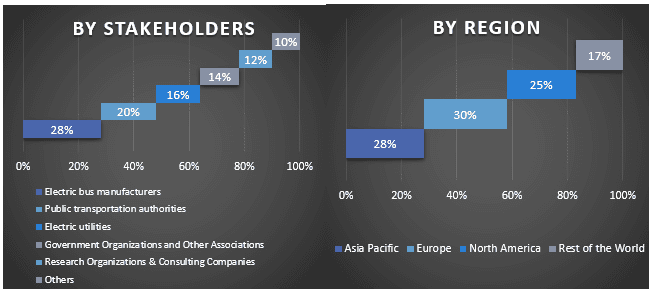Emphasis on Propulsion Type (Battery Electric Vehicles (BEV), Hybrid Electric Vehicles (HEV), Plug-In Hybrid Vehicles (PHEV), and Fuel Cell Electric Vehicles (FCEV)); Length (<9m, 9m-14m, and >14m); Range (Up to 150 Miles, 151-300 miles, Above 300 miles); Battery Capacity (Less than 100kWh, 100-300kWh, and More than 300kWh); and Region/Country

The Electric Buses market was valued at USD 4.5 Billion in 2021 & is expected to grow at a strong CAGR of around 19.8% during the forecast period owing to the growing concern about the environment and increasing government incentives. An electric bus is a type of public transportation vehicle that runs on electricity instead of fossil fuels. It has several advantages, including reduced emissions, lower operating costs, reduced noise pollution, and improved air quality. The growth of the electric bus market is being driven by government regulations, increasing demand for zero-emission transportation, advances in battery technology, and investment in charging infrastructure.
Some of the major players operating in the market include AB Volvo; Anhui Ankai Automobile Co., Ltd; BYD Company Ltd; CAF, Construcciones y Auxiliar de Ferrocarriles, S.A; EvoBus GmbH; NFI Group; Proterra; YUTONG; Zhongtong Bus Holding Co., Ltd; VDL Groep. Several M&As along with partnerships have been undertaken by these players to facilitate customers with hi-tech and innovative products/technologies.
Insights Presented in the Report
“Based on the propulsion, the market has been categorized as BEV, HEV, PHEV, and FCEV. Among them, the BEV segment held a considerable share of the market in 2022.”
Based on the propulsion, the market has been categorized as BEV, HEV, PHEV, and FCEV. Among them, the BEV segment held a considerable share of the market in 2022. A battery electric vehicle, or BEV, is a type of vehicle that runs solely on electric power. BEVs use only an electric motor powered by rechargeable batteries, these batteries are usually made of lithium-ion cells and can be charged by plugging the vehicle into an electric power source. Moreover, the batteries used in BEVs have a voltage ranging from 300-400 volts. Therefore, more adoption of BEVs will have a positive impact on the EV battery market. Several instances below are driving the growth of the market. For instance, On February 13, 2023, Toyota Is Finally Accelerating BEV Development Specifically, next-generation BEVs for the Lexus brand by 2026.
“Based on the length, the market has been categorized into <9m, 9-14m, and >14m. Among them, <9m segment held a considerable share of the market in 2022.”
Based on the length, the market has been categorized into <9m, 9-14m, and >14m. Among them, the <9m segment held a considerable share of the market in 2022. The market for electric buses under 9 meters in length has witnessed a surge in recent years to attain environmentally friendly transportation solutions. Various key players in the automotive industry have introduced electric bus models tailored to meet the specific requirements of smaller urban routes. For instance, European bus manufacturers e.GO Mobile AG unveiled the e.GO Mover, an electric minibus designed for urban mobility. The e.GO Mover’s compact size, combined with its emission-free operation, makes it suitable for shuttle services and transportation within city centers. These instances highlight the investment and product launches in the electric bus market under 9 meters, emphasizing the industry’s commitment to providing sustainable and efficient transportation options for urban environments with limited space and high demand.
“Europe will hold the 2nd highest share of the electric buses market in 2022.”
Europe has been at the forefront of adopting electric vehicles (EVs) as part of its commitment to achieving zero emissions. The region has set ambitious targets to transition away from traditional combustion engines and embrace cleaner transportation options. The European Union’s Green Deal and the European Commission’s “Fit for 55” package aim to reduce carbon emissions and promote sustainable mobility. As a result, many European countries have implemented policies to incentivize the purchase and use of electric vehicles, including electric buses.
Electric Buses Market Report Coverage

Reasons to buy this report:
Customization Options:
The global electric buses market can further be customized as per the requirement or any other market segment. Besides this, UMI understands that you may have your own business needs, hence feel free to contact us to get a report that completely suits your requirements.
1. Market Introduction
2. Research Methodology Or Assumption
3. Market Synopsis
4. Executive Summary
5. Global Electric Buses Market Covid-19 Impact
6. Global Electric Buses Market Revenue, 2020-2030f
7. Market Insights By Propulsion Type
8. Market Insights By Length
9. Market Insights By Range
10. Market Insights By Battery Capacity
11. Market Insights By Region
12. Global Electric Buses Market Dynamics
13. Global Electric Buses Market Opportunities
14. Global Electric Buses Market Trends
15. Demand And Supply-side Analysis
16. Value Chain Analysis
17. Conference And Events
18. Competitive Scenario
19. Companies Profiled
20. Disclaimer
Research Methodology for the Electric Buses Market Analysis (2022-2030)
Analyzing the historical market, estimating the current market, and forecasting the future market of the global electric buses market were the three major steps undertaken to create and analyze the adoption of electric buses in major regions globally. Exhaustive secondary research was conducted to collect the historical market numbers and estimate the current market size. Secondly, to validate these insights, numerous findings and assumptions were taken into consideration. Moreover, exhaustive primary interviews were also conducted, with industry experts across the value chain of the global electric buses market. Post assumption and validation of market numbers through primary interviews, we employed a top-down/bottom-up approach to forecasting the complete market size. Thereafter, market breakdown and data triangulation methods were adopted to estimate and analyze the market size of segments and sub-segments of the industry pertains to. Detailed methodology is explained below:
Analysis of Historical Market Size
Step 1: In-Depth Study of Secondary Sources:
Detail secondary study was conducted to obtain the historical market size of the electric buses market through company internal sources such as annual reports & financial statements, performance presentations, press releases, etc., and external sources including journals, news & articles, government publications, competitor publications, sector reports, third-party database, and other credible publications.
Step 2: Market Segmentation:
After obtaining the historical market size of the electric buses market, we conducted a detailed secondary analysis to gather historical market insights and share for different segments & sub-segments for major regions. Major segments are included in the report by propulsion type, length, range, and battery capacity. Further country-level analyses were conducted to evaluate the overall adoption of testing models in that region.
Step 3: Factor Analysis:
After acquiring the historical market size of different segments and sub-segments, we conducted a detailed factor analysis to estimate the current market size of the electric buses market. Further, we conducted factor analysis using dependent and independent variables such as propulsion type, length, range, and battery capacity of the electric buses market. A thorough analysis was conducted of demand and supply-side scenarios considering top partnerships, mergers and acquisitions, business expansion, and product launches in the electric buses market sector across the globe.
Current Market Size Estimate & Forecast
Current Market Sizing: Based on actionable insights from the above 3 steps, we arrived at the current market size, key players in the global electric buses market, and market shares of the segments. All the required percentage shares split, and market breakdowns were determined using the above-mentioned secondary approach and were verified through primary interviews.
Estimation & Forecasting: For market estimation and forecast, weights were assigned to different factors including drivers & trends, restraints, and opportunities available for the stakeholders. After analyzing these factors, relevant forecasting techniques i.e., the top-down/bottom-up approach were applied to arrive at the market forecast for 2028 for different segments and sub-segments across the major markets globally. The research methodology adopted to estimate the market size encompasses:
Market Size and Share Validation
Primary Research: In-depth interviews were conducted with the Key Opinion Leaders (KOLs) including Top Level Executives (CXO/VPs, Sales Head, Marketing Head, Operational Head, Regional Head, Country Head, etc.) across major regions. Primary research findings were then summarized, and statistical analysis was performed to prove the stated hypothesis. Inputs from primary research were consolidated with secondary findings, hence turning information into actionable insights.
Split of Primary Participants in Different Regions

Market Engineering
The data triangulation technique was employed to complete the overall market estimation and to arrive at precise statistical numbers for each segment and sub-segment of the global electric buses market. data was split into several segments & sub-segments post studying various parameters and trends in the areas of the propulsion type, length, range, and battery capacity in the global electric buses market.
The main Objective of the Global Electric Buses Market Study
The current & future market trends of the global electric buses market were pinpointed in the study. Investors can gain strategic insights to base their discretion for investments on the qualitative and quantitative analysis performed in the study. Current and future market trends determined the overall attractiveness of the market at a regional level, providing a platform for the industrial participant to exploit the untapped market to benefit from a first-mover advantage. Other quantitative goals of the studies include:

Customers who bought this item also bought